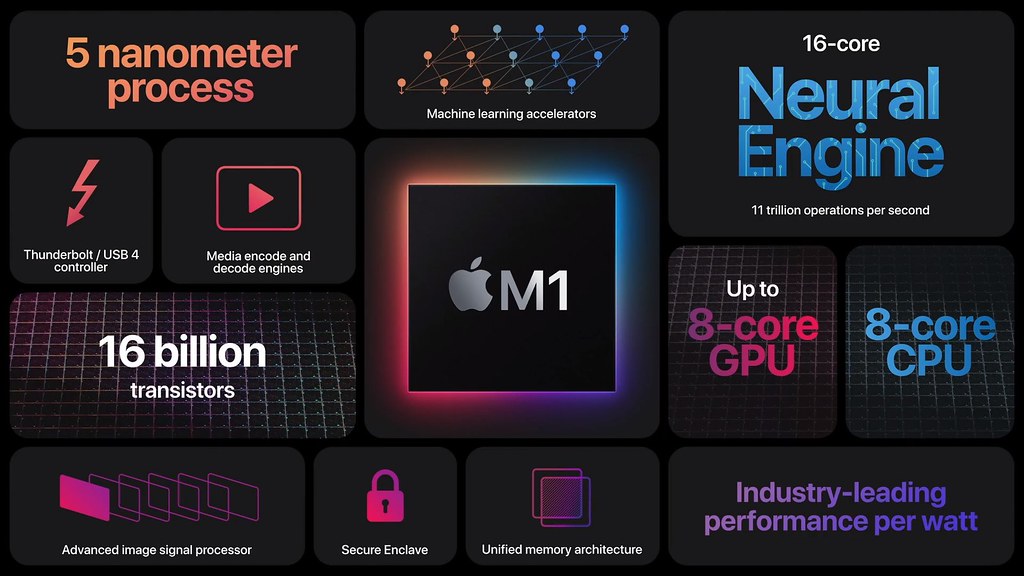Apple announced their move away from Intel processors back in June and promised by the end of the year they’ll launch a new Mac lineup that uses their own chip. Things got exciting when they launched the iPad Air back in September that features their newest processor – the A14 Bionic which is made using a 5nm process, making it more efficient per watt.
Now, the wait is finally over as for the third consecutive month, Apple occupied the headlines with their new M1 processor and a new Mac lineup.
Apple M1
After years of making their own processors for the iPhone, iPad, and Apple Watch, Tim Cook and co. did the bold move of making their own processors for the Mac line. The new M1 features the same 5nm process as the A14 processor but packs a lot more power, having 16 billion transistors inside.
The new M1 has 4 high-performance CPU cores, 4 low-power CPU cores, up to 8 GPU cores, up to 16GB RAM, 16-core Neural engine, Thunderbolt/USB-4 controller, secure enclave, and advanced image processor. It promises up to 3.5x faster CPU performance, 6x faster GPU performance, and up to 2x longer battery life for the Macbooks.

What sets it apart from the usual processor used in laptops and desktops is the integration of units. Unlike in PCs, laptops, and previous Macs where the processor is separate from the graphics, memory, and input/output controller on the motherboard, the M1 has all of it in the processor housing. This means less distance for the signal to travel, meaning quicker execution when you’re using the Mac.
With the hardware and software now both made and designed by Apple, apps can now be shared between platforms, making iOS and iPadOS apps available for Macs.
Macbook Air
The new Macbook Air with the M1 processor has been supercharged to do way more than what it used to. It can now do machine learning tasks up to 9x faster, has 2x faster SSD performance, integrate 3D effects in Final Cut Pro up to 5x faster, edit 4K ProRes videos in full quality without a drop in frame rate, and can last up to 15 hours of wireless web browsing or 18 hours of video playback.

If you’re curious as to a real comparison of the new processor, head over to this article from Mac Rumors where they showed how the M1 in the Macbook Air is better than even the Intel Core i9 in the 16-inch Macbook Pro. Insane, I know.
The M1 processor in the new Macbook Air is so efficient that Apple didn’t put a fan inside, leading to a totally silent laptop no matter your workload.
13-inch Macbook Pro
People are disappointed yet again with the 13-inch MBP because it still doesn’t have the screen upgrade like it’s bigger brother 15-inch MBP that’s now 16-inch with smaller bezels. However, the M1 chip gives it way more power than anything in its class.

Unlike the Air, the new MBP has an active cooling fan that leads to 2.8x faster performance, 5x faster GPU, and 11x faster machine learning. Pro tasks like recording multiple tracks in Logic Pro, editing 8K ProRes in DaVinci Resolve, machine learning, and coding are all done much faster too. On top of that, since it has a bigger battery than the Air, it can last up to 17 hours of wireless web browsing and up to 20 hours of video playback.
Mac Mini
The new Mac Mini with the M1 chip is basically the Macbook Pro without the keyboard, screen, and trackpad. It has an advanced thermal design compared to the previous version, and its compact form factor makes it more affordable for almost the same performance as the Macbook Pro.

The new M1 chip together with the macOS Big Sur also boosts the security of the new devices, protecting users from more vulnerability than their counterparts in the PC side of things. It has hardware-verified secure boot, automatic high-performance encryption, and macOS run-time protection assuring all your info and data are secured while using a Mac.
Apps that can utilize the full capability of the M1 and macOS Big Sur are few at the moment, but Apple’s Rosetta2 lets you use the Intel version of the app for the meantime. As for users of older Macbooks that won’t transition yet to the new chip, it remains to be seen how long they would be supported by Apple and app developers alike.
Availability for the new lineup will be in the coming weeks, but the prices are already out on Apple PH. They generally retained the same pricing, with the Macbook Air starting at P54,990, the 13-inch Macbook Pro at P71,990, and the Mac Mini at P37,990.












